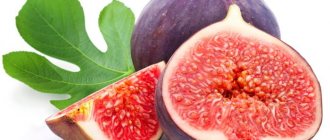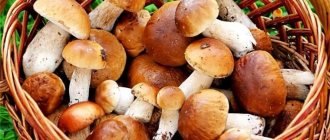A woman's diet while breastfeeding should be varied and include everything necessary for the proper development of the child.
Cauliflower is included in the list of foods recommended for breastfeeding. It ranks 14th in the list of products with a high index of preventive nutritional value (ANDI - Aggregate Nutrient Density Index) [1, 2]. Every day, a nursing mother needs to eat at least 400 grams of various vegetables in several doses [3]. Among these vegetables, cauliflower should also be present.
Chemical composition and effect on the body
Cauliflower is a source of vitamins A, B, PP, C, K. It contains a lot of potassium, calcium, iron, antioxidants, and fiber.
When consuming 100 grams of the product, the body receives [4]:
- 3.3% of the recommended daily intake of protein;
- 10.5% fiber;
- 13.3% potassium;
- 4.3% magnesium;
- 6.4% phosphorus;
- 7.8% iron;
- 3.6% calcium;
- 5.6% riboflavin;
- 18% pantothenic acid;
- 9% choline and folic acid;
- 8% vitamin B6;
- 13.3% vitamin K;
- 77.8% vitamin C.
The energy value of 100 grams of this cabbage is only 30 kcal.
Impact on the body of a nursing mother [5, 2]
Cruciferous crops, including cauliflower, contain sulforaphane. This substance has cytoprotective properties, reduces the risk of developing cancer, heart and vascular diseases.
Choline (vitamin B4) improves the transport of substances through the membranes of all cells and ensures the conduction of nerve impulses. [6]
Cauliflower is a supplier of essential amino acids: tryptophan (consumption of 100 g of product covers 10% of the daily requirement), threonine, methionine, histidine, valine and others.
Composition and properties of cauliflower
This representative of the cruciferous family received its name due to the inflorescences on the surface, shaped like flowers. And the word “cabbage” comes from the Latin caput - “head”.
Cauliflower comes from Syria; Avicenna praised the vegetable for its nutritional properties; It came to Europe in the 14th century and spread throughout the Mediterranean countries. When the heat-loving vegetable was brought to Russia under Catherine II, it did not take root in the north for a long time, but more than a hundred years ago it was possible to develop a variety that was not afraid of cold weather.
Despite the fact that cauliflower is a finicky crop, requiring careful watering and mineral fertilizers, it is often found in Russian garden beds: grown strong, without defects, heads of cabbage are the pride of the owners. The “curly” vegetable is loved for its taste and the benefits it brings to the body. It is useful not only in cooking, but also in folk medicine - it is part of the means to combat diseases of the liver, stomach, and intestines.
In Russia, cauliflower has become resistant to cold weather, but growing a healthy head of cabbage requires effort
How is the product useful for a nursing mother?
Allergy becomes a big problem for a woman who has given birth to a baby. After childbirth, the body's sensitivity to the components of various dishes increases; Even those who previously “behaved decently” cause an adverse reaction. Cauliflower is a hypoallergenic vegetable and extremely rarely upsets a nursing mother with negative consequences. Pediatricians list cabbage as one of the safest foods to eat during breastfeeding.
Contains cauliflower:
- vitamins A, C, E, group B (including B9 - folic acid);
- micro- and macroelements - calcium, iron, magnesium, phosphorus, potassium, sodium, zinc;
- phytosterol (prevents cholesterol from clogging blood vessels);
- protein;
- fiber (helps cleanse the intestines);
- tartronic acid (prevents the formation of fatty deposits);
- citric acid (fights toxins).
Folic acid is necessary for a nursing mother: it will return the woman to a healthy, blooming appearance, and relieve anemia for both her and the baby.
50 grams of cauliflower contains the daily requirement of vitamin C. For a woman who has just given birth, ascorbic acid, which gives the skin firmness and elasticity, is an excellent remedy for stretch marks.
After giving birth, a woman’s stretch marks do not go away for a long time; vitamin C in cauliflower will help get rid of unsightly stripes
In the cruciferous family, cauliflower is the leader in the amount of nutrients. Those who eat the product regularly receive:
- Full absorption of useful elements, removal of harmful ones. The fiber in cabbage stimulates the production of enzymes responsible for normal food digestion.
- Beneficial microflora in the intestines, the development of which is helped by cauliflower juice.
- Protection against gastritis, ulcers, bladder diseases.
- Reducing the risk of cancer by 5 times.
- Protection against influenza, ARVI, because substances in cabbage prevent the development of infection.
- Cleansing blood vessels, relief from heart disease, reducing the likelihood of stroke, myocardial infarction.
- Normalization of the nervous system, relief from stress.
- Strengthening the immune system.
- Cheerfulness, good health.
Cauliflower is also considered a dietary product because it contains few carbohydrates: 100 grams of the vegetable contains only 30 kilocalories. If a woman has gained excess weight during pregnancy and does not know what to do, hearty and low-calorie dishes with cauliflower will help solve the problem.
If we compare two types of cabbage - cauliflower and white cabbage - the first is the leader in the following indicators:
- vitamin C content is 3 times higher;
- protein content is 2 times higher.
Due to its rich protein content, cauliflower is nutritious: it replaces meat for vegetarians.
For nursing mothers, the fundamental difference between the two types of cabbage is that cauliflower contains significantly less fiber. Coarse fibers, reaching the baby through breast milk, cause fermentation in the intestines and severe colic; therefore, white cabbage should be excluded from the menu in the first 5 months after childbirth. But the ban does not apply to colored vegetables: they contain exactly as much fiber as is required for normal intestinal motility. In addition, the product rarely causes an allergic reaction in the baby.
If a mother eats cauliflower, the child will not suffer from flatulence: there is little fiber in such cabbage
The “curly” representative of the cruciferous family is a vegetable with an impeccable reputation: the World Health Organization recommends that cauliflower be included as one of the first vegetables in complementary foods for infants. This is a high assessment of product safety. So nursing mothers can delight themselves with cauliflower dishes - aromatic, tasty and healthy.
True, you can’t do without precautions.
When is cauliflower bad for your health?
It happens that a woman has an individual intolerance to a particular product. Cauliflower is no exception: no, no, and it will cause allergies.
There are diseases in which eating a healthy vegetable will only worsen the condition. A breastfeeding woman should remove cauliflower from her diet if she has:
- increased stomach acidity;
- acute enterocolitis;
- stomach ulcer;
- gout (cabbage contains purines, which provoke an increase in the concentration of uric acid, which means a relapse of the disease is possible);
- the functioning of the thyroid gland is disrupted (goitrogens in cabbage cause a deficiency of thyroid hormones).
However, as for goitrogens, many doctors believe that complications will occur only if you regularly abuse dishes with cauliflower. Also, if you overeat, fiber will make itself felt - inevitable bloating.
For diseases of the digestive system, vegetables containing coarse fibers are contraindicated: they irritate the mucous membranes of the stomach and intestines and cause severe pain. Doctors advise those who have undergone abdominal and chest surgery to avoid eating cauliflower.
In rare cases, the baby’s body “responds” with an allergy to the mother’s consumption of cabbage. Then it is better to give up the product for a month. Then try to accustom the baby to cabbage again.
Video: what cauliflower does to the human body
Methods for preparing cauliflower for a nursing mother
The method of processing the vegetable is important.
It is best to steam it: this preserves the maximum amount of vitamins. You can cook in a slow cooker, microwave, or with the lid closed in a small amount of water and not for long.
You can also stew and bake cauliflower, but frying is strictly not recommended.
Cauliflower: are there any contraindications?
Soon after the baby is born, the mother's diet undergoes significant changes. Many familiar products acquire “banned” status. Cauliflower is a safe food; it can be eaten during breastfeeding without risk to health. There are only two conditional contraindications under which it is worth limiting the consumption of this vegetable. This:
- individual intolerance to the product;
- the occurrence of food allergies in the mother/baby.
Finding out how the baby tolerates a new component in the mother’s diet is quite simple. It is enough to make sure that after introducing the product (taking into account the first three days):
- The child did not develop redness or rashes on the skin.
- There is nothing to worry about the child’s gastrointestinal tract.
- The baby's general health has not deteriorated, he is not irritable and does not show sudden, inexplicable dissatisfaction after feeding.
If no unusual symptoms are observed, then a nursing mother can safely plan to prepare dishes from tasty and appetizing cauliflower for her table.
Cauliflower dishes: sample list
Vegetable stew with vegetable oil (sunflower, olive, rapeseed).
Meat soup with vegetables . You can take low-fat varieties of meat (turkey, veal, rabbit), drain the first broth, and prepare soup on the second. You can add cereals (buckwheat, oatmeal, corn).
Omelet with cauliflower.
Fresh Cauliflower Salad
Pickled cauliflower can be used in small quantities.
Expert opinion
Sokolova L. S.
Pediatrician of the highest category
Of all the thermally processed vegetables, baked cauliflower retains the maximum amount of vitamins and minerals.
Cauliflower during breastfeeding - is it possible?
The diet of a nursing mother, especially in the early stages after the birth of a child, is strict. The menu is thought out to the smallest detail, and each component must be approved by the attending physician. The visiting nurse gives the most specific instructions regarding the nutrition of the mother who has given birth, including recommendations on the consumption of vegetables.
Cauliflower is allowed during breastfeeding and is included in the list of foods acceptable for consumption during the lactation period. But, according to nutritionists, there is no need to rush into introducing cauliflower immediately after childbirth. When developing a diet for nursing mothers, experts noted that the best period for including cauliflower dishes in maternal nutrition is 3 months after the birth of the baby.
Contraindications and possible harm
During breastfeeding, it is worth considering not only the beneficial properties of the vegetable, but also contraindications to its use. There are very few of them, but in some cases it is necessary to completely exclude or limit cauliflower in the diet:
- individual intolerance, allergic reactions in the mother;
- similar manifestations in a child;
- skin rash;
- diarrhea;
- constipation.
If such symptoms appear, eating vegetables while breastfeeding should be stopped completely. It can be resumed only six months after consultation with a doctor.
Rules for using the product. Who is cauliflower recommended for?
When breastfeeding, children's doctors do not recommend that women eat food that can cause allergies in the newborn. Immediately after giving birth, the diet of a young mother is very strict. But gradually, day by day, you can start eating nutritiously. Cauliflower is unlikely to cause any unpleasant symptoms in the baby, even if the mother eats a little in the first days after the start of lactation. And proof of this is the numerous positive reviews from women about the vegetable. After all, it is absolutely safe provided that the person does not have individual intolerance. But in order to completely protect yourself and your newborn, you should follow some rules for introducing a product such as cauliflower into the menu. While breastfeeding you can:
- eat vegetables only in boiled form, starting from the 3-4th week after birth;
- for the first time, use no more than 100 grams. ready dish.
After introducing a new type of food, it is necessary to carefully monitor the baby’s reaction throughout the day. If his health has not changed, there is no allergic reaction, and his stool is normal, then mom can safely eat 200 grams every day. cauliflower.
Vegetable soup
Required components:
- 2 liters of water;
- 0.4 kg of lean meat;
- 3 potatoes;
- greens, salt (to taste);
- carrot;
- 0.3 kg of inflorescences.
We recommend reading: Products that increase breast milk lactation
Actions:
- First you need to boil the meat in brackish water, then transfer it to a separate plate.
- Place peeled potatoes, chopped into small pieces, into the prepared meat broth.
- Cook for about 10 minutes, then add the cabbage florets.
- After ¼ hour, add the peeled, grated carrots.
- Cook for another 8 - 10 minutes, then add finely chopped herbs.
The dish is ready.
Dish recipes
An important advantage of cauliflower is that it does not require lengthy cooking. You don’t need to spend a lot of time to prepare the inflorescences, and this is very important for a young mother. There are many recipes for how to deliciously cook cauliflower, so every mother can choose the dish that she likes.
Cauliflower with sauce
- Place the inflorescences in boiling water with a little salt.
- Boil the inflorescences until tender.
- For the sauce, place a saucepan with butter (about 15 grams) on the fire. Pour wheat flour (also approximately 15 grams) into the melted butter. While continuously stirring the sauce, pour 150 ml of milk into it. Keep on low heat until the sauce thickens.
- Pour the sauce over the prepared inflorescences.
Vegetable stew
Required ingredients:
- 2-3 potatoes;
- 150 grams of inflorescences;
- 1 medium carrot;
- 1 small zucchini.
Preparation:
- Peel the potatoes and zucchini and cut into cubes.
- Grate the carrots on a coarse grater.
- Place the vegetables in boiling water and cook until tender.
- At the end, add salt if desired, sprinkle with chopped parsley and dill.
Chicken soup with vegetables and cheese
Ingredients:
- 300 grams of chicken fillet;
- Several potatoes;
- 300 grams of cabbage inflorescences;
- 1 medium carrot;
- Greenery;
- Hard cheese – 30 grams.
Preparation:
- Place the chicken fillet, cut into pieces, into a saucepan with 2 liters of water. Cook until half cooked with the addition of bay leaf and a small amount of salt.
- Add diced potatoes and grated carrots to the soup.
- Place the inflorescences in the pan after 10 minutes.
- Cook for another 10-15 minutes. Sprinkle the soup with finely grated cheese, chopped parsley and dill.
Cauliflower in the oven with cheese
- 1 head of cabbage;
- 1 egg;
- 100 gr. hard cheese;
- 3 tbsp. l. mayonnaise or sour cream;
- herbs, salt and pepper to taste.
Divide the cabbage into inflorescences, wash thoroughly and place in boiling and salted water. Cook for 5–7 minutes over medium heat, covered. Drain the water, cool the cabbage and place it on a greased baking sheet with the florets facing up in one layer. Beat the egg, add sour cream, grated cheese, finely chopped herbs. Pour the resulting mixture over the cabbage and place in the oven for 10–15 minutes. The dish is ready when the cheese has melted and the cabbage has acquired a beautiful golden crust.
Benefits for nursing mother and baby
The value of a food product, as well as its effect on the body, is calculated based on its composition. Therefore, there is no doubt about the beneficial properties of cauliflower.
- The high content of vitamin C strengthens the immune system and reduces the likelihood of contracting viral and infectious diseases.
- Cauliflower lowers the level of unwanted cholesterol in the blood. Normalizes the quantitative component of lipids.
- Provides prevention of breast cancer.
- Doctors recommend the vegetable when fighting extra pounds. Despite the extensive mineral reserves, the product is low in calories. There are only 30 kcal in 100g.
- Fiber normalizes metabolism and intestinal function. If a woman has problems with bowel movements after childbirth, then this product will help solve them.
- It is important for infants that cauliflower is a low-allergenic vegetable. Allergic reactions are quite rare.
- Another advantage for babies is that the product does not cause colic or increased gas formation in the intestines. This is a fairly common occurrence in young children.
You can learn how to properly introduce cauliflower into your baby’s complementary foods from this article.
Contraindications
Mothers with illnesses should not eat cauliflower.:
- Gastrointestinal tract, gastritis, pancreatitis, ulcer;
increased stomach acidity;- intestinal colic;
- problems with the genitourinary system;
- hypertension;
- kidney diseases.
Also, you should not eat vegetables if you have an individual intolerance. You should discard the product if allergic rashes or changes in the color of the child’s skin are noticed. If the baby develops bloating, colic, or cramps in the intestines, exclude cauliflower from the woman’s menu. Read more about the beneficial and harmful properties, as well as for which diseases you need to use cauliflower with caution here.










